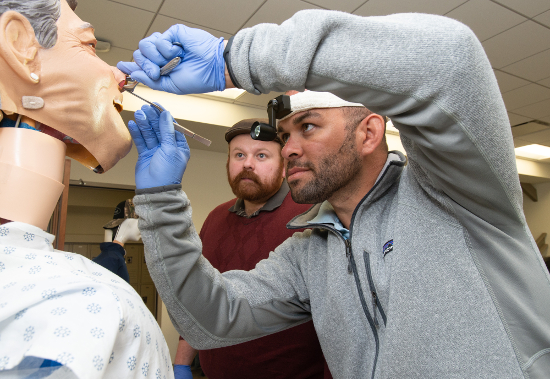
The Simulation Center at the medical school’s W.E. Upjohn M.D. Campus is a hub of activity for medical students, residents and several community agencies, and 2018 was a record year.
In all, the Simulation Center team hosted a total of 871 events and more than 15,000 learners last year, and more than 71,000 learner hours were logged. Those figures are part of what has been a period of exponential growth over the last three years.
For example, in 2016, the Simulation Center hosted 443 events for more than 9,600 learners with 44,000 learner hours tallied. In 2017, there were 668 events with more than 14,600 learners and more than 62,000 learner hours logged.
“WMed faculty are excited about using simulation as a tool for medical education,” said Dr. Richard Lammers, the medical school’s assistant dean for Simulation. “And awareness has also grown in the community from positive feedback.”
The number of trainings that were held in the Simulation Center last year included 498 undergraduate medical education events, 279 graduate medical education events and 94 events that involved external agencies, such as local hospitals and EMS providers.
Figures from the Simulation Center show that the growth in activity has been fueled by an increase in the breadth of simulation cases and the overall number of events that are being held in the 24,000 square-foot facility.
Those events have included advanced procedure labs and PGY-2 and PGY-3 assessments during Emergency Medicine Sim Wednesdays and ultrasound training courses for Medicine-Pediatrics, Family Medicine and Emergency Medicine residents, as well as procedural skills, OSCE and clinical skills stations for pre- and post-clerkship events for third-year medical students.
Additionally, the Simulation Center hosted trainings and events for entities outside of the medical school, including Stryker, Bronson Healthcare, West Michigan AirCare and grant-funded programs such as the Michigan Pediatric EMS Error Reduction Study (MI-PEERS) and Cradle Kalamazoo.
Dr. Lammers said he is proud of the extensive growth in activity at the Simulation Center and thankful for the work of staff, standardized patients, standardized patient educators and American Heart Association instructors that have made it all possible.
He said he also is encouraged by the positive feedback he has received from students and residents who have trained in the Simulation Center and he is confident that the skills they obtain and sharpen in the facility are having a positive impact on patient care.
In one instance, Dr. Lammers received a message from an Emergency Medicine resident who credited his training in the Simulation Center during an advanced procedures lab on a Sim Wednesday for preparing him to remove a metal flake that had become embedded in a patient’s eye.
“Not only did the sim training allow me to set up the slit lamp correctly, but it also gave me the skills necessary to successfully remove the metal flake using a 21g needle in my non-dominant hand,” Dr. Sean Barkan said. “Without this prior training, I would not have felt comfortable attempting the difficult procedure.”
Dr. Lammers said he believes the Simulation Center at the W.E. Upjohn M.D. Campus will soon reach capacity and he anticipates that staff will begin holding more events at the WMed Simulation Center at Ascension Borgess Hospital.
“I’ve seen simulation used as a valuable education tool for a long time and I think the residents and students are getting richer experiences as a result of using the Simulation Center,” Dr. Lammers said. “I’ve never had anyone write me a letter because a lecture I gave made them feel more confident about performing a procedure or managing a case. Simulation is more effective in improving learners’ confidence. I think they learn skills faster and the training sticks longer.”
